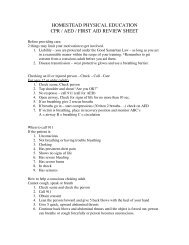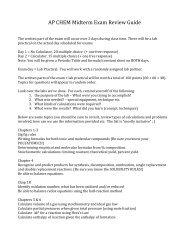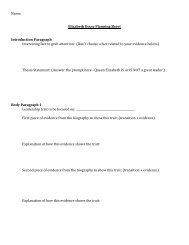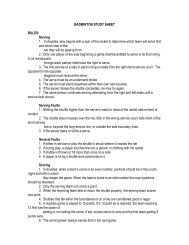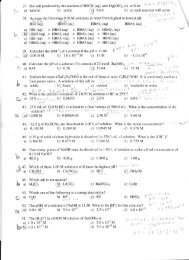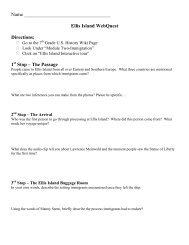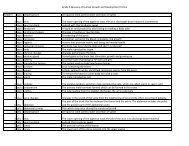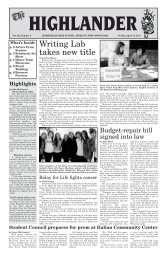TABLE TENNIS STUDY GUIDE
TABLE TENNIS STUDY GUIDE
TABLE TENNIS STUDY GUIDE
You also want an ePaper? Increase the reach of your titles
YUMPU automatically turns print PDFs into web optimized ePapers that Google loves.
<strong>TABLE</strong> <strong>TENNIS</strong> <strong>STUDY</strong> <strong>GUIDE</strong><br />
The Basics<br />
Table tennis (originally known as Ping Pong, a term never to be spoken in class) is<br />
played on a 9’ x 5’ table that is 30” high and has a 6” net dividing the table in half. There<br />
are side lines and end lines on the table. The center line is only used in doubles play for<br />
serving purposes. The playing surface includes the top edges of the table, but not the<br />
sides below the edge. Players use wooden paddles that have rubber covering the hitting<br />
surface to hit a ball across the net. The object is to hit the ball onto the opponent’s side of<br />
the table without the opponent being able to return the ball.<br />
Scoring<br />
The scoring system is the same for singles and doubles. A match consists of the best<br />
two-out-of-three games played to 11. Players alternate serves every two points and<br />
change ends after each game. The winner must be ahead by 2 to end the game, and the<br />
person or team that is behind will always serve at game point, regardless of whose turn it<br />
is. Either the server or receiver can score a point on any play. A player scores a point<br />
when the opponent:<br />
• Fails to make a good serve<br />
• Fails to make a good return<br />
• Allows the ball to bounce twice in his/her court<br />
• Strikes the ball twice in making one return<br />
• Moves the table while the ball is in play<br />
• Touches the playing surface, the net, or its supports while the ball is in play<br />
• Strikes the ball out of sequence in doubles play<br />
Serving<br />
The server holds the ball on the open, flat palm of his/her free hand. The ball must be<br />
above the table and behind the end line on the table. The racket must also be above the<br />
table. The server tosses the ball up at least 6 inches, without spinning it. The server<br />
strikes the ball on the descent with the racket behind the end line. The ball must touch<br />
the server’s court first, pass over or around the net, and then touch the receiver’s court. A<br />
serve that hits the net and goes over is a ‘let’ and must be served again. If a player misses<br />
the ball while attempting to serve, he/she loses a point.<br />
In doubles, the served ball must hit on the server’s right-hand court and then the<br />
receiver’s right-hand court. Doubles also has a set serving order. Each player serves five<br />
points at a time in this repeating order:<br />
• Player 1, Team A (serving to Player 1, Team B)<br />
• Player 1, Team B (serving to Player 2, Team A)<br />
• Player 2, Team A (serving to Player 2, Team B)<br />
• Player 2, Team B (serving to Player 1, Team A)
Returns<br />
A return is good when it passes over or around the net or its supports and strikes the<br />
opponent’s court. A return may touch the net or its supports, so long as it lands in the<br />
opponent’s court. The ball may not bounce twice on the same side, or be hit twice on the<br />
same side, before its return.<br />
Ball In Play<br />
A ball in play must be allowed to bounce before it is struck. A player that plays the ball<br />
before it bounces will lose the point. Once the ball has passed the back line on the fly,<br />
however, the ball is out of play, and the player that hit the ball out will lose the point<br />
regardless of the actions of the other player.<br />
As mentioned earlier, a serve that hits the net and goes over is a ‘let’ and must be served<br />
again. A serve that hits the net and fails to go over is not served again – it is a loss of<br />
point for the server.





